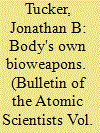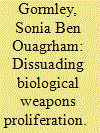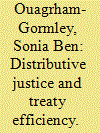| Srl | Item |
| 1 |
ID:
112469


|
|
|
|
|
| Publication |
2012.
|
| Summary/Abstract |
Although the issue of knowledge diffusion has been at the heart of nonproliferation research and policies, no study in the political science field has thus far systematically identified the mechanisms that allow the acquisition and efficient use of specialized knowledge related to bioweapons. This analytical gap has led to the commonly held belief that bioweapons knowledge is easily transferable. Studies of past weapons programs, including the former U.S. and Soviet bioweapons programs, show that gathering the relevant information and expertise required to produce a weapon is not sufficient to guarantee success. The success of a bioweapons program is dependent on intangible factors, such as work organization, program management, structural organization, and social environment, which can enhance the advancement of a program or create obstacles to progress. When assessed within smaller state and terrorist bioweapons programs, such as those of South Africa and the terrorist group Aum Shinrikyo, these intangible factors produce the same constraining effects as in larger programs. More important, intangible factors have a significant effect on covert programs, because clandestinity imposes greater restrictions on knowledge diffusion. By taking into account these intangible factors, analysts and policymakers can improve their threat assessments and develop more effective nonproliferation and counterproliferation policies.
|
|
|
|
|
|
|
|
|
|
|
|
|
|
|
|
| 2 |
ID:
080826


|
|
|
| 3 |
ID:
124994


|
|
|
|
|
| Publication |
2013.
|
| Summary/Abstract |
The terrorist and anthrax attacks of 2001 spurred many countries to raise defences against a possible biological weapon attack, and potentially dissuade state and non-state actors from developing these weapons. Yet these programmes' dissuasive value - creating strong barriers to entry - has never been analysed. This article argues that current biodefence efforts are counterproductive and more persuasive than dissuasive, because they rest on a biological threat narrative that emphasizes the benefits of bioweapons rather than their problematic development and use, and they fail to impose a high cost of entry in the bioweapons field. The dominant biological weapons narrative perpetuates several misconceptions, including that there are no barriers to biological weapons development, that expertise is easily acquired from scientific documents, and that new technologies are black boxes with de-skilling effects. The net result is popularization of a cost/benefit analysis in favour of bioweapons development. To remedy the situation, I suggest correcting these misconceptions by reshaping the biological threat narrative, and recommend policies to achieve a greater dissuasive impact, stressing the role of the Biological Weapons Convention, preventing access to tacit biological weapons skills, and criminalizing bioweapons proliferation by making the development and use of biological weapons a crime against humanity.
|
|
|
|
|
|
|
|
|
|
|
|
|
|
|
|
| 4 |
ID:
135249


|
|
|
|
|
| Summary/Abstract |
This article evaluates the security value of controls over biotechnology transfers and of new restrictions on the spread of scientific results: to what extent do they improve the implementation of the Biological Weapons Convention (bwc)? Although the questions of justice that have plagued the bwc regime since its creation in 1972 have been analyzed extensively, the effects of current controls over dual-use research and the propagation of scientific results on the implementation of the bwc have not been fully addressed. It is argued that although controls over biotechnology transfers increase security because they delay covert programs by creating integration challenges, controls on the spread of scientific results have no security value. They instead may lead to a decreased implementation of the bwc.
|
|
|
|
|
|
|
|
|
|
|
|
|
|
|
|